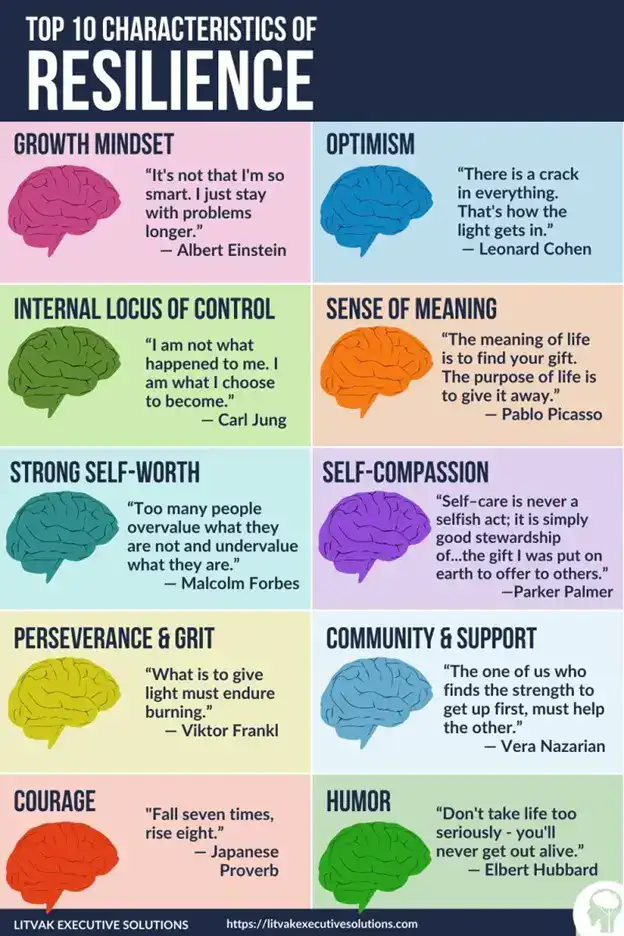Resilience is the ability to adapt, recover, and even grow stronger in the face of adversity. While some people seem naturally resilient, it’s a skill that can be cultivated. The infographic “Top 10 Characteristics of Resilience” by Litvak Executive Solutions breaks down the key traits that help individuals thrive despite challenges.
Let’s explore each characteristic and how you can develop them in your own life.
1. Growth Mindset
“It’s not that I’m so smart. I just stay with problems longer.” — Albert Einstein
A growth mindset is the belief that abilities and intelligence can be developed through effort and learning. Resilient people see failures as opportunities to improve rather than as dead ends.
How to cultivate it:
- Embrace challenges as learning experiences.
- Replace “I can’t do this” with “I can’t do this yet.”
- Seek feedback and use it to grow.
2. Internal Locus of Control
“I am not what happened to me. I am what I choose to become.” — Carl Jung
People with an internal locus of control believe they have power over their outcomes, rather than feeling like victims of circumstance.
How to strengthen it:
- Focus on what you can control (actions, attitudes, responses).
- Take responsibility for your choices.
- Avoid blaming external factors for setbacks.
3. Strong Self-Worth
“Too many people overvalue what they are not and undervalue what they are.” — Malcolm Forbes
Self-worth is the foundation of resilience. When you believe in your own value, setbacks don’t define you.
How to build it:
- Practice self-affirmations.
- Celebrate small wins.
- Surround yourself with people who uplift you.
4. Optimism
“There is a crack in everything. That’s how the light gets in.” — Leonard Cohen
Optimism doesn’t mean ignoring reality—it means believing that good outcomes are possible. Resilient people find hope even in tough situations.
How to practice it:
- Reframe negative thoughts (“This is hard, but I can handle it”).
- Focus on solutions, not just problems.
- Keep a gratitude journal.
5. Sense of Meaning
“The meaning of life is to find your gift. The purpose of life is to give it away.” — Pablo Picasso
People with a strong sense of meaning endure hardships better because they see a bigger purpose in their struggles.
How to find it:
- Reflect on what truly matters to you.
- Engage in activities that align with your values.
- Help others—it reinforces purpose.
6. Self-Compassion
“Self-care is never a selfish act; it is simply good stewardship of…the gift I was put on earth to offer to others.” — Parker Palmer
Resilience isn’t about toughness—it’s about treating yourself with kindness when you fail or struggle.
How to develop it:
- Talk to yourself like you would a friend.
- Allow yourself to rest and recover.
- Accept that imperfection is part of being human.
7. Perseverance & Grit
“What is to give light must endure burning.” — Viktor Frankl
Grit is the determination to keep going despite obstacles. Resilient people don’t give up easily.
How to build grit:
- Set long-term goals and break them into steps.
- Embrace discomfort as part of growth.
- Remember past challenges you’ve overcome.
8. Community & Support
“The one of us who finds the strength to get up first, must help the other.” — Vera Nazarian
No one is resilient alone. Strong relationships provide emotional support and encouragement.
How to nurture it:
- Reach out to friends, family, or mentors.
- Join groups with shared interests or struggles.
- Be willing to ask for (and accept) help.
9. Courage
“Fall seven times, rise eight.” — Japanese Proverb
Courage isn’t the absence of fear—it’s moving forward despite it.
How to cultivate courage:
- Take small risks to build confidence.
- Face fears gradually (exposure therapy).
- Remind yourself of past bravery.
10. Humor
“Don’t take life too seriously—you’ll never get out alive.” — Elbert Hubbard
Laughter reduces stress and helps put problems in perspective.
How to use humor:
- Find lightness in difficult situations.
- Watch or read something funny daily.
- Don’t be afraid to laugh at yourself.
Final Thoughts: Resilience is a Skill, Not a Trait
Resilience isn’t something you’re born with—it’s built through practice. By developing these 10 characteristics, you can bounce back from setbacks stronger than before.
Which trait do you want to strengthen first? Start small, be patient, and remember: every challenge is an opportunity to grow.
“The oak fought the wind and was broken. The willow bent when it must and survived.” — Robert Jordan

Credits to Litvak Executive Solutions (https://litvakexecutivesolutions.com).
Would you like a printable checklist or action plan to work on these traits? Let me know!

